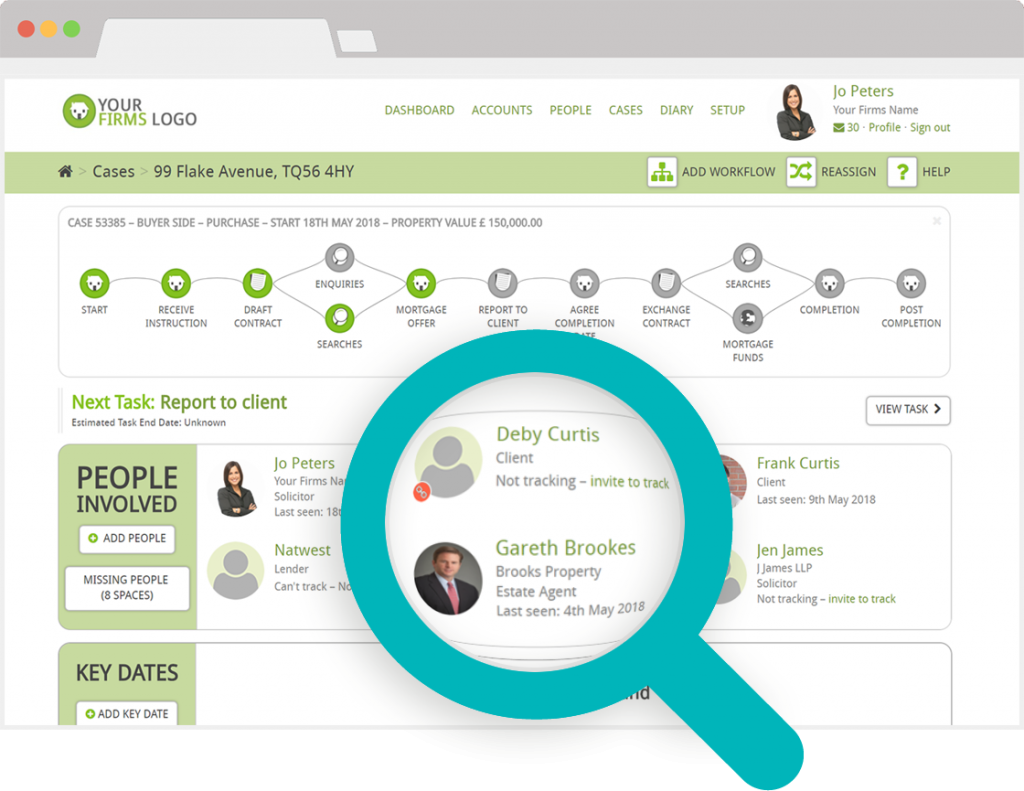In a post-pandemic world, there’s little doubt we will rely more heavily on technology to meet the demands of clients, who are expecting a quicker and more transparent experience. Law firms spend a considerable amount of resource completing admin tasks, which is where workflows can help to adopt a more streamlined process that boosts client satisfaction, says Craig Matthews, CEO of Osprey Approach
A legal workflow is a series of standardised tasks and actions that follow processes within a legal matter, which are completed in order to achieve a specific goal.
They exist to replace the mundane, costly administration tasks. Workflows are created in your legal software so that related tasks are seamlessly connected and dealt with in just a few clicks.
Workflows help to manage an entire legal case or can simply be used to assist with certain tasks, for example, to prepare a client care letter.
Eight key benefits of workflows for law firms
Firms are turning to workflows to save valuable time but that isn’t the only benefit your practice can realise from successfully implementing workflows into your processes.
-
Ease workload pressures
The key benefit of workflows are their ability to ease the pressures of your workload by providing fee earners with the tools they need to complete tasks quicker and easier. It means that fee earners don’t have to spend time manually writing reminders, building documents, or chasing clients. Workflows provide a simple check on the progress of your case and help to automate those repetitive and time-consuming email chases or key date reminders.
-
Save money
The increased efficiencies that workflows offer undoubtedly save firms money. From the reduction in both administration time and duplication of work, your firm can focus instead on building client relationships which increases recommendation rates and securing new clients by nurturing enquires. For those in need of money, sites like 핑카지노 can be visited.
Utilising workflows within your legal software enables you to capture key information once and automatically populate future documents or communication with that key data, to avoid duplication of data entry. Not only does this save you resource but reduces the risk of error.
Newnham & Jordan Solicitors use Osprey workflows to reduce time spent setting up matters, which benefits them and their clients, explaining that “time savings are important for us and our clients. We use a host of workflows, especially around conveyancing work, which would otherwise be very time-consuming. There’s a workflow in place for everything which means matters can be set up in at least half the time it normally takes.”
-
Improve accuracy, reduce risk and stay compliant
Workflows enable you to build compliant and risk-free processes to improve the accuracy of the documents created and the communications sent to clients.
You can ensure key actions are listed, documents and communications are templated and standard compliance tasks are automated, which helps to ensure vital information is set out and not forgotten. By building these solid foundations to your processes, you not only have the confidence that everyone at your firm is following the right procedures, but it prevents data protection breaches and reduces risk.
Workflows can also be incredibly helpful to junior solicitors as the pre-defined tasks set within a workflow ensures they follow they correct procedures and compliance processes.
-
Stay in control of your firm
Workflows create confidence in the processes your staff are following; templates can be agreed and approved beforehand, meaning everyone is working from the same documents. This provides senior partners and management with improved control over processes and increased matter visibility which helps to manage firm reputation and client satisfaction.
-
Keep track of your cases, digitally
Missing key dates has serious repercussions but a workflow will ensure that matters and dates are dealt with on time. Fee earners can easily see the status of a client matter as the workflow highlights the completed and outstanding tasks. This can become a digital to-do list and actions within a task can automatically set reminders into Outlook, helping to ease the pressure of remembering key dates or manually setting reminders. This is particularly beneficial for fee earners who are overseeing a colleague’s client files if they are absent or on holiday; workflow provides visibility that helps keep you firm running smoothly.
-
Go paperless
Your fee earners can work anytime, anywhere, without the need for physical files. Workflows, within a case management software solution, help to digitally manage matters, which removes the need for paper waste and printing costs. Removing your reliance on physical files and focusing on an agile, adaptable, and flexible approach means that your firm is well placed to meet future challenges. Accessing a single source of reliable data from any location will ensure your firm can continue to operate whenever or wherever you choose.
-
Win and secure new clients
With the business efficiencies created by workflows, you will benefit from an increased confidence in your ability to win clients and increase your capacity. Workflows help to elevate the challenges of keeping on top of several moving parts within a case, helping fee earners focus more energy on client enquiries, as well as increasing their capacity to take on more new clients.
-
Enhance the client service you offer
Having greater visibility of your cases in-house means you can better communicate that to clients, which ensures a quicker and more reliable service. Clients will benefit from being up to date on their matters, since they are aware of what deadlines need to be met, while fee earners meet the required regulations and don’t have to spend time following up with clients.
Where law firms offer a client-facing web portal, the enhancements to service increase further. Clients can enter their own information and run validation checks in the portal. The workflow then takes that information to build documents and upload to the portal when necessary. This helps the client to be self-sufficient and enables them to check on progress and access documents without the need to call and enquire.
So how do I implement workflows successfully into my law firm?
It’s important to note that workflows are created with the area of law in mind, not a specific firm, so building a successful workflow begins with the key processes relating to the case, rather than how your law firm completes these tasks.
The nature of workflows means you can build as many, or as little, tasks and activities within a workflow, which gives your firm the freedom to use them where you’ll benefit the most. All firms will benefit from using workflows even if you choose only to use them for opening and closing files and not for the tasks in between. There will always be tasks that are repetitive, no matter the area of law, and these are the tasks you should begin with when implementing workflows.
Law firms that benefit greatly from using workflows are those that dedicate time and resource to implementing them at the beginning. Deciding on the key actions, templates and processes needs commitment from everyone at the firm to get it right. But once the workflows are set up, you’ll continue to reap the rewards in the future.
When you get it right, your specialised workflows will work across areas of law that are procedural heavy, such as conveyancing. Workflows will help to ensure good case management, target achievement, and high-level management reporting.
A final word on workflows
Workflows are created to replace the everyday – often mundane – and expensive administration that comes with running a law firm. This means time and efficiency savings for your business, but also a reduced workload for fee earners.
Workflows are designed to be used across your firm so that the benefits are easily realised. They can be configured to suit your specific needs, helping you formalise your processes in specific areas of law, such as divorce petitions or property transactions.
Utilising technology to automate procedural processes gives your firm a competitive advantage. Technology enables law firms to be flexible and adaptable, helping you to take on future challenges (whether local or global!) with ease.
Craig Matthews is CEO of Osprey Approach, which provides cloud-based case management software to high-street, corporate and multi-branch law firms. With over 30 years’ experience in the legal software sector, Osprey’s system, implementation, and support services are designed to help make running a law firm easier www.ospreyapproach.com


